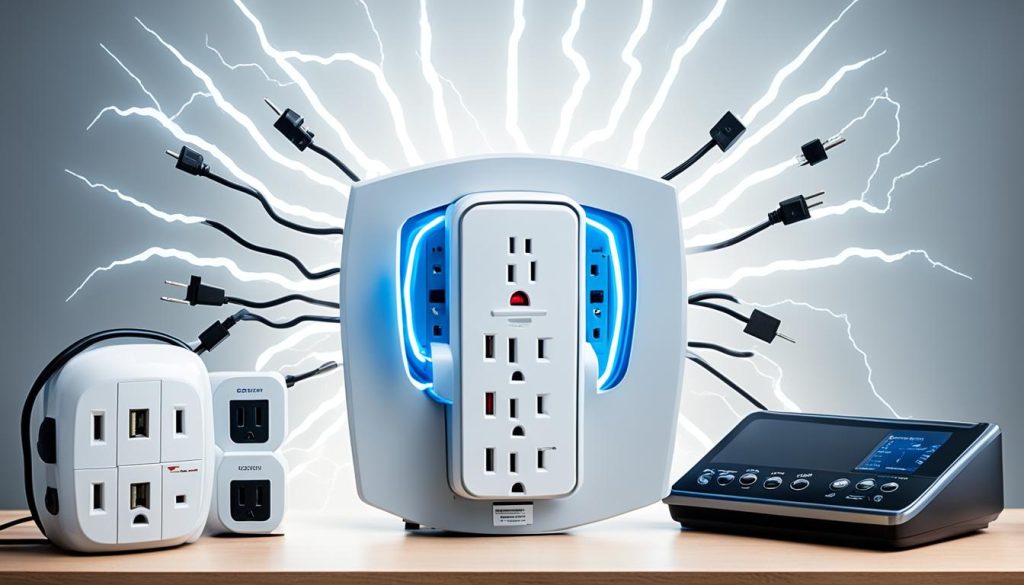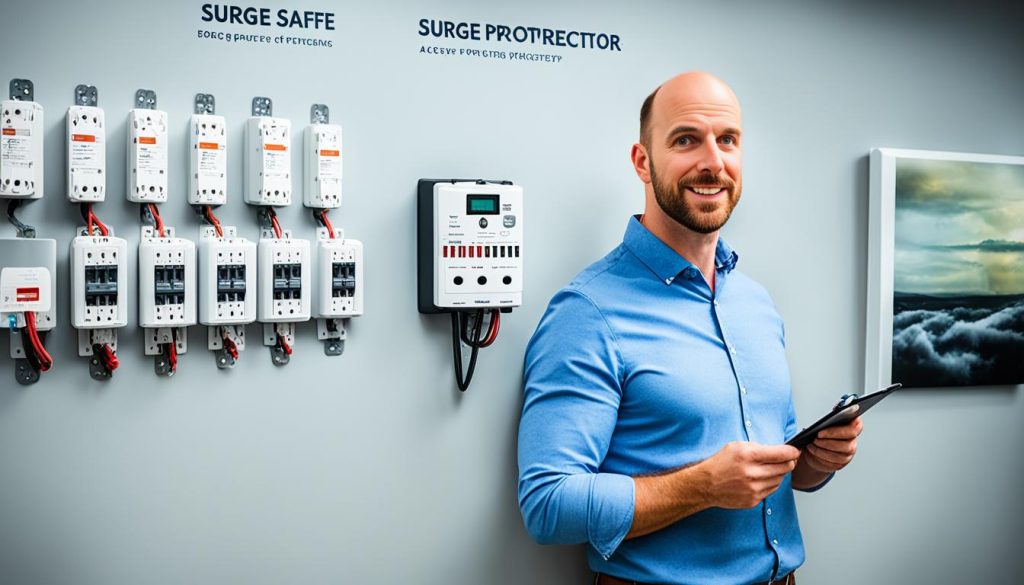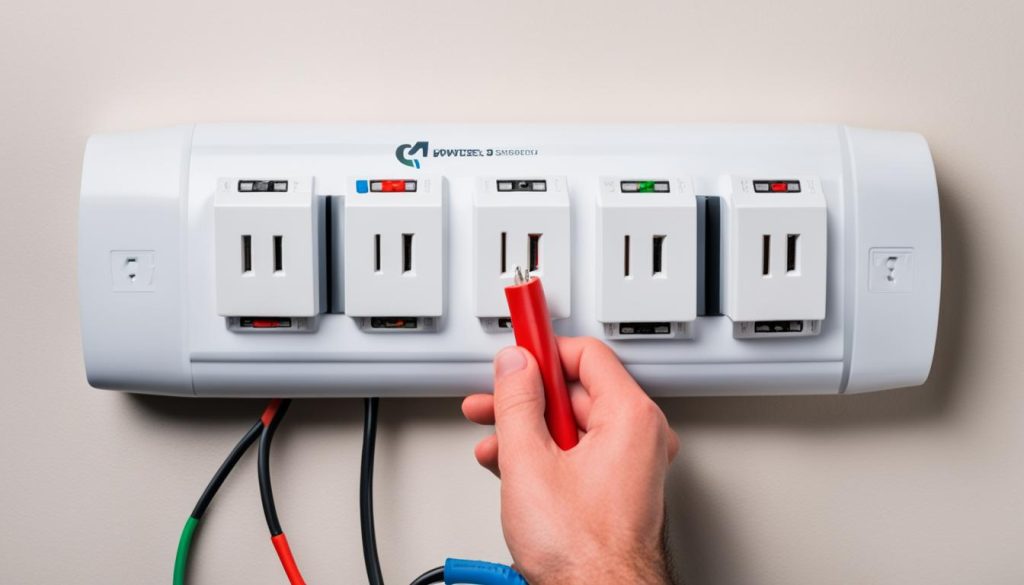Protecting your home and valuable electronics from power surges is essential. You never know when a sudden surge in voltage could occur, potentially causing irreversible damage to your devices. That’s where whole house surge protectors come in. But how do these devices actually work to keep your home safe?
Whole house surge protectors are designed to divert excess voltage away from your electrical system and appliances. They act as a line of defense, intercepting any power surges that could otherwise wreak havoc on your valuable electronics. By grounding the excess voltage, surge protectors prevent it from entering your home and causing damage.
To better understand the functionality of whole house surge protectors, it’s important to grasp the concept of surge protection itself. Power surges can be caused by various factors, such as lightning strikes, faulty wiring, or fluctuations in electricity. These surges can have devastating effects on your electrical system and appliances, leading to expensive repairs or replacements.
By installing a whole house surge protector, you can effectively mitigate the risks associated with power surges. These devices provide comprehensive protection for your entire home, safeguarding not just your appliances but also your electrical system, including outlets, light switches, and circuit breakers.
Now that you understand the importance of surge protection and the role whole house surge protectors play, let’s dive deeper into how these devices function and the different types available in the market.
Key Takeaways:
- Whole house surge protectors divert excess voltage away from your electrical system and appliances, preventing damage from power surges.
- Power surges can occur due to factors like lightning strikes, faulty wiring, or fluctuations in electricity.
- Whole house surge protectors provide comprehensive protection for your home, safeguarding both your appliances and electrical system.
- Understanding how whole house surge protectors work is crucial for protecting your investments and extending the lifespan of your electronics.
- Choosing the right surge protector for your needs and ensuring proper installation and maintenance are essential steps in safeguarding your home.
The Importance of Surge Protection
Power surges pose a significant threat to your electrical system and appliances, making surge protection a crucial aspect of home safety. Whether caused by lightning strikes, downed power lines, or fluctuations within your own home, power surges can wreak havoc on your valuable electronics. Installing a surge protector is a proactive measure that can save you from costly repairs and replacements.
Why Surge Protection Matters
Power surges can occur at any time, and the consequences can be extensive. These sudden increases in voltage can damage sensitive electronic components, leading to malfunctions, shortened lifespans, or complete failure. From your everyday appliances to high-tech devices, everything connected to your electrical system is at risk. Surge protection ensures that your investments remain safe and your home stays powered.
“Investing in surge protection is like having an insurance policy for your electronics. It provides an additional layer of security and peace of mind knowing that you’re prepared for whatever power fluctuations come your way.” – John Adams, Electrical Expert
The Role of Surge Protectors
Surge protectors act as the first line of defense against power surges by diverting excess voltage away from your devices. They work by monitoring the electrical flow and redirecting any spikes to a grounding wire or rod. This process helps stabilize the voltage, protecting your appliances and preventing potential damage.
There are various types of surge protectors available, each serving different purposes:
| Type of Surge Protector | Features |
|---|---|
| Whole House Surge Protector | Installed at the electrical panel, provides comprehensive protection for your entire home |
| Surge Protector Power Strip | Offers surge protection for multiple devices in one convenient strip |
| Surge Protector for Appliances | Specifically designed to safeguard high-value appliances such as refrigerators and washing machines |
Choosing the right surge protector depends on your specific needs and the level of protection required.
Installation and Maintenance
Installing surge protectors, especially whole-house surge protectors, typically requires the expertise of a licensed electrician. They will ensure the proper placement and grounding of the surge protector to maximize its effectiveness. Regular maintenance, including periodic inspections and testing, is also recommended to ensure that your protection remains intact.
Remember, surge protectors have a lifespan and may need replacement at some point. Be sure to check the manufacturer’s recommendations regarding replacement intervals and warranty coverage.
Investing in surge protection is a wise decision that offers long-term savings and peace of mind. Don’t wait for a power surge to take a toll on your valuable electronics and appliances. Take the necessary steps to protect your home and enjoy uninterrupted power for years to come!
How Do Whole House Surge Protectors Function?
Whole house surge protectors act as essential pressure-relief valves for your home’s electrical system, offering comprehensive protection against destructive power surges. Unlike power strips, whole house surge protectors are hard-wired to your service panel, providing enhanced defense for all electrical devices and appliances throughout your entire home.
When a power surge occurs, caused by external factors like lightning strikes or fluctuations in the electricity supply, the surge protector diverts the excess voltage to the ground, preventing it from reaching and damaging your valuable electronics. This proactive approach safeguards against expensive repairs or replacements, saving you time, money, and frustration.
Compared to power strips, which only offer limited protection for individual devices, whole house surge protectors deliver superior performance and benefits. These include:
- Comprehensive Protection: Whole house surge protectors shield all electronic devices and appliances in your home, including those that are typically not plugged into power strips, such as HVAC systems, security systems, and built-in appliances.
- Higher Surge Ratings: Whole house surge protectors have surge ratings of at least 40,000 amps, ensuring they can handle larger surges and protect your electronic equipment more effectively compared to power strips, which typically have lower surge ratings.
- Long-Term Cost Savings: By preventing damage caused by power surges, whole house surge protectors help you avoid costly repairs or replacements of appliances and electronics. This investment provides long-term cost savings and peace of mind.
- Convenience and Ease: Whole house surge protectors are installed directly at your service panel, eliminating the need for multiple power strips or individual surge protectors throughout your home. This streamlined approach enhances convenience and reduces clutter.
- Increased Home Value: Having a whole house surge protector installed can be an attractive feature for potential homebuyers. It demonstrates that your home’s electrical system is well-protected and can increase the overall value of your property.

Types of Surge Protectors
When it comes to surge protectors, there are various options available to meet different needs. Understanding the different types can help you choose the right one for your specific requirements. Let’s explore some common types of surge protectors:
Surge Stations
If you want comprehensive protection for not only plug-in devices but also phone lines and coaxial cables, surge stations are an ideal choice. These surge protectors ensure that all communication lines are safeguarded against harmful voltage spikes, giving you peace of mind.
Circuit Protectors
Circuit protectors, such as power strips, are popular for offering basic surge protection for multiple devices. Designed with multiple outlets, these surge protectors are perfect for protecting your everyday electronics, like computers, televisions, and gaming consoles.
Uninterruptible Power Supply (UPS)
For those seeking not only surge protection but also battery backup during power outages, uninterruptible power supplies (UPS) are an excellent choice. UPS devices provide continuous power to your electronics, ensuring uninterrupted operation and protecting valuable data.
Choosing the right surge protector depends on your specific needs and the level of protection required. Whether it’s securing your phone lines, safeguarding multiple devices, or ensuring uninterrupted power, there’s a surge protector available to meet your demands.

Key Considerations when Buying Surge Protectors
When it comes to purchasing a surge protector, there are some key factors to consider that will help you make an informed decision. Taking the time to understand surge protector features and specifications will ensure that you choose the right one for your specific needs.
Meeting the Standards: UL Standard 1449 and Clamping Voltage
First and foremost, look for surge protectors that meet UL Standard 1449. This standard ensures that the surge protector has undergone rigorous testing to provide reliable surge protection. Additionally, pay attention to the clamping voltage, which refers to the maximum voltage the surge protector allows before it starts redirecting excess voltage. Opt for surge protectors with a clamping voltage of 400 volts or less for optimal protection against power surges.
Joule Ratings: Energy Absorption Capabilities
Another important factor to consider is the joule rating of the surge protector. Joules represent the surge protector’s ability to absorb energy from power surges. Higher joule ratings indicate better energy absorption capabilities, providing increased protection for your valuable electronics. Look for surge protectors with higher joule ratings to ensure maximum protection.
Protection for All Three Lines
When buying a surge protector, it’s crucial to ensure that it offers protection for all three incoming lines: hot, neutral, and ground. This comprehensive protection ensures that your entire electrical system is safeguarded against power surges. Be sure to check the specifications of the surge protector to confirm that it provides protection for all three lines.
Lifespan and Warranty
Consider the lifespan and warranty of the surge protector before making a purchase. A reliable surge protector should have a long lifespan and a warranty that provides coverage in case of any issues. Look for surge protectors with extended lifespans and warranties to ensure long-term protection and peace of mind.
By considering these key factors, you can confidently choose a surge protector that will meet your specific needs and provide reliable protection for your valuable electronics and appliances.

Installation and Maintenance of Surge Protectors
Installing a whole house surge protector is a crucial step in protecting your home’s electrical system and appliances from potentially damaging power surges. While the installation process may require the assistance of a licensed electrician, it ensures that the surge protector is properly connected to your service panel, providing comprehensive protection throughout your home.
When installing a surge protector, it’s important to consider additional protection for your phone and cable lines. These lines can also be vulnerable to power surges and may require separate surge protectors. Consulting a professional will help determine the best setup for your specific needs.
Surge Protector Installation Tips:
- Consult a licensed electrician for proper installation.
- Ensure the surge protector is installed at the service panel.
- Consider separate surge protectors for phone and cable lines.
Once your surge protector is installed, proper maintenance is essential to ensure optimal functionality. Regular maintenance helps identify any issues or damage that may compromise the effectiveness of the surge protector.
Surge Protector Maintenance Tips:
- Regularly inspect the surge protector for any signs of damage or wear.
- Check that all connections are secure and free from corrosion.
- Follow the manufacturer’s instructions for any recommended maintenance procedures.
Furthermore, proper grounding is critical for surge protectors to function effectively. The surge protector should be grounded according to the manufacturer’s instructions. This grounding provides a pathway for excess voltage to safely dissipate, protecting your appliances and electronics.
Surge Protector Grounding:
- Follow the manufacturer’s instructions for proper grounding.
- Ensure a proper ground connection by using approved grounding methods.
- Consult a professional if you have any doubts or questions about the grounding process.
By following these surge protector installation tips, conducting regular maintenance, and ensuring proper grounding, you can maximize the effectiveness of your surge protector and provide long-lasting protection for your home’s electrical system and appliances.

The Cost of Whole-House Surge Protectors
When it comes to protecting your home and valuable electrical equipment, investing in a whole-house surge protector is a wise choice. The cost of whole-house surge protectors can vary depending on several factors that you should consider before making a purchase.
The size of your home is one of the key factors that can affect the cost of a whole-house surge protector. Larger homes may require a more powerful surge protector, which could result in a higher cost. Additionally, the specific features and capabilities of the surge protector can also influence its price. Surge protectors with advanced features, such as LED indicators or advanced diagnostic capabilities, may come at a higher price point.
On average, the cost for protecting an average house with 200-amp service is around $500, including installation by a licensed electrician. While the upfront cost of a whole-house surge protector may seem significant, it is important to consider the long-term benefits. Investing in a surge protector can potentially save you thousands of dollars in damages caused by power surges, protecting your valuable electronics and appliances.
Ultimately, the cost of a whole-house surge protector is a small price to pay for the peace of mind and protection it provides. By considering factors such as the size of your home and the specific features you require, you can make an informed decision and safeguard your home against the unpredictable nature of power surges.
FAQ
How do whole house surge protectors work?
Whole house surge protectors work by diverting excess voltage to the ground, preventing it from damaging your electronics. They are typically hard-wired to your service panel and have a rating to stop a surge of at least 40,000 amps.
Why is surge protection important?
Surge protection is important because power surges can cause severe damage to your electrical system and appliances. Installing a surge protector, such as a whole house surge protector, can effectively mitigate the risk of damage and maintain the functionality of your appliances.
What are the benefits of whole house surge protectors?
Whole house surge protectors offer comprehensive protection for your entire home and are a more reliable option than power strips. They safeguard your home’s electrical system and appliances from unexpected voltage spikes, ensuring the longevity of your electrical equipment.
What are the different types of surge protectors available?
There are different types of surge protectors available, including surge stations, circuit protectors (power strips), and uninterruptible power supplies (UPS). Surge stations are ideal for protecting phone lines and coaxial cable in addition to plug-in devices.
What should I consider when buying a surge protector?
When buying a surge protector, consider factors such as meeting UL Standard 1449, having a clamping voltage of 400 volts or less, higher joule ratings, protecting all three incoming lines (hot, neutral, and ground), and the lifespan and warranty of the surge protector.
How should I install and maintain a surge protector?
Installing a whole house surge protector typically requires the assistance of a licensed electrician. It should be installed at the service panel and may also require separate protectors for phone and cable lines. Proper grounding and regular maintenance are crucial for optimal functionality.
How much does a whole-house surge protector cost?
The cost of whole-house surge protectors can vary depending on factors such as the size of your home and the specific features and capabilities of the surge protector. On average, the cost for protecting an average house with 200-amp service is around $500, including installation.


